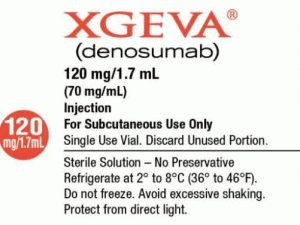地诺单抗注射溶液denosumab(Xgeva 120mg Injektionslösung)
 产地国家:德国
处方药:是
所属类别: 120毫克/ 1瓶/盒
包装规格: 120毫克/ 1瓶/盒
计价单位:瓶
生产厂家英文名:Amgen Inc
原产地英文商品名:Xgeva 120mg/ 1vial/box
原产地英文药品名:denosumab
中文参考商品译名:Xgeva注射溶液 120毫克/ 1瓶/盒
中文参考药品译名:地诺单抗
产地国家:德国
处方药:是
所属类别: 120毫克/ 1瓶/盒
包装规格: 120毫克/ 1瓶/盒
计价单位:瓶
生产厂家英文名:Amgen Inc
原产地英文商品名:Xgeva 120mg/ 1vial/box
原产地英文药品名:denosumab
中文参考商品译名:Xgeva注射溶液 120毫克/ 1瓶/盒
中文参考药品译名:地诺单抗
简介:
近日,美国FDA已批准XGEVA(denosumab)的补充生物制剂许可证申请(sBLA),扩大当前Xgeva预防实体瘤患者骨骼相关事件(SREs)的适应症,纳入多发性骨髓瘤(MM)患者。Xgeva是一种单克隆抗体药物,靶向结合RANK配体(RANKL)来抑制骨细胞(osteoclast)的形成、功能及生存,而骨细胞负责骨吸收,会破坏骨骼。骨骼并发症(例如:骨折,脊髓压迫)和放疗及骨骼手术,对于MM患者而言是灾难性的。由于许多患者会遭受肾功能损害,因此限制了其临床治疗选择。Xgeva具有独特的作用机制,能够有效预防多发性骨髓瘤患者的骨骼并发症,而且其疗效与患者肾功能状态无关,该药有望解决多发性骨髓瘤患者群体中远未满足的显著医疗需求。批准日期:2017年10月18日 公司:安进公司Xgeva(地诺单抗[denosumab])注射液,用于皮下注射美国最初批准:2010年最近的重大变化实体肿瘤的适应症和用法,多发性骨髓瘤和骨转移:01/2018警告和注意事项,治疗后高血钙症停药:06/2018警告和注意事项,多个椎骨骨折(MVF)治疗后停止:01/2018警告和注意事项,胚胎 - 胎儿毒性:01/2018作用机制Xgeva与RANKL结合,RANKL是一种跨膜或可溶性蛋白质,对破骨细胞的形成,功能和存活至关重要,破骨细胞是负责骨吸收的细胞,从而调节骨骼中钙的释放。由RANKL刺激的增加的破骨细胞活性是具有骨转移的实体瘤中骨病理的介质。类似地,骨的巨细胞瘤由表达RANKL的基质细胞和表达RANK受体的破骨细胞样巨细胞组成,并且通过RANK受体的信号传导有助于骨溶解和肿瘤生长。Xgeva阻止RANKL在破骨细胞,其前体和破骨细胞样巨细胞表面激活其受体RANK。 适应症:Xgeva是一种RANK配体(RANKL)抑制剂,适用于:预防多发性骨髓瘤患者和实体瘤骨转移患者的骨骼相关事件。治疗成人和骨骼成熟的青少年骨巨细胞瘤无法切除或手术切除可能导致严重的发病率。治疗双膦酸盐治疗难治性恶性肿瘤的高钙血症。 剂量和给药:Xgeva仅用于皮下途径,不应静脉内,肌肉内或皮内给药。 多发性骨髓瘤和实体肿瘤的骨转移:在上臂,大腿上部或腹部皮下注射,每4周施用120mg。 骨巨细胞瘤:在治疗第一个月的第8天和第15天,每4周施用120mg,另外施用120mg剂量。皮下注射在上臂,大腿上部或腹部。必要时给予钙和维生素D以治疗或预防低钙血症。 恶性高钙血症:在治疗的第一个月的第8天和第15天,每4周施用120mg,另外施用120mg剂量。皮下注射在上臂,大腿上部或腹部。 剂量形式:在单剂量小瓶中的120mg/1.7mL(70mg/mL)溶液 禁忌症:低钙血症已知临床上对Xgeva的超敏反应。相同的有效成分:接受Xgeva的患者不应服用Prolia®。可能发生包括过敏反应的过敏反应。如果发生临床显着反应,则永久停用。 注意事项: 低钙血症:Xgeva可引起严重的症状性低钙血症,并且已报道致命病例。在开始Xgeva之前纠正低钙血症。在治疗期间监测钙水平,特别是在开始治疗的第一周,并充分补充所有钙和维生素D患者。在接受Xgeva的患者中已经报道了颌骨坏死(ONJ)。在开始Xgeva之前进行口腔检查。监测症状。在使用Xgeva治疗期间避免使用侵入性牙科手术。 非典型股骨骨折:评估大腿或腹股沟疼痛患者,以排除股骨骨折。 骨巨细胞瘤患者和骨骼生长患者停用治疗后的高钙血症:监测患者高钙血症的体征和症状,并按临床情况进行治疗。 治疗中断后多发性椎体骨折(MVF):停止Xgeva治疗时,评估患者椎体骨折的风险。 胚胎-胎儿毒性:可能导致胎儿伤害。告知女性对胎儿有潜在风险的生殖潜力并使用有效的避孕措施。 不良反应: 实体瘤的骨转移:最常见的不良反应(≥25%)是疲劳/虚弱,低磷血症和恶心。 多发性骨髓瘤:最常见的不良反应(≥10%)是腹泻,恶心,贫血,背痛,血小板减少,外周性水肿,低钙血症,上呼吸道感染,皮疹和头痛。 骨巨细胞瘤:最常见的不良反应(≥10%)是关节痛,头痛,恶心,背痛,疲劳和四肢疼痛。 恶性高钙血症:最常见的不良反应(> 20%)是恶心,呼吸困难,食欲减退,头痛,外周性水肿,呕吐,贫血,便秘和腹泻。 用于特定人群: 儿科患者:建议仅用于治疗骨巨细胞瘤的骨骼成熟青少年。 肾功能损害:肌酐清除率低于30mL/min或接受透析的患者存在低钙血症的风险。充分补充钙和维生素D. 包装:Xgeva采用单剂量小瓶供应。每箱120mg/1.7mL 1vial NDC 储存:将Xgeva存放在原装纸箱中2°C至8°C(36°F至46°F)的冰箱中。不要冻结。一旦从冰箱中取出,Xgeva不得暴露在高于25°C/77°F的温度或直射光下,必须在14天内使用。如果在14天内没有使用,请丢弃Xgeva。保护Xgeva免受直射光和热。避免剧烈摇晃Xgeva。 完整说明书资料附件:https://dailymed.nlm.nih.gov/dailymed/drugInfo.cfm?setid=628f0998-1206-4001-aeee-18133aa9f3bf英文版说明书:
Xgeva(denosumab )injection, for subcutaneousImportant Safety InformationDo not take XGEVA® if you have low blood calcium (hypocalcemia). Your low blood calcium must be treated before you receive XGEVA®. XGEVA® can significantly lower the calcium levels in your blood and some deaths have been reported. Take calcium and vitamin D as your doctor tells you to. Tell your doctor right away if you experience spasms, twitches, cramps, or stiffness in your muscles or numbness or tingling in your fingers, toes, or around your mouth.Do not take XGEVA® if you are allergic to denosumab or any of the ingredients of XGEVA®. Serious allergic reactions have happened in people who take XGEVA®. Call your doctor or go to your nearest emergency room right away if you have any symptoms of a serious allergic reaction, including low blood pressure (hypotension); trouble breathing; throat tightness; swelling of the face, lips, or tongue, rash; itching; or hives.What is the most important information you should know about XGEVA®?Do not take XGEVA® if you take Prolia. XGEVA® contains the same medicine as Prolia® (denosumab).Severe jaw bone problems (osteonecrosis)Severe jaw bone problems may happen when you take XGEVA®. Your doctor should examine your mouth before you start, and while you are taking XGEVA®. Tell your dentist that you are taking XGEVA®. It is important for you to practice good mouth care during treatment with XGEVA®. In studies of patients with bone involvement, the rate of severe jaw problems was higher the longer they were being treated with XGEVA®.Unusual thigh bone fractureUnusual thigh bone fracture has been reported. Symptoms of a fracture include new or unusual pain in your hip, groin, or thigh.Risk of high calcium levels in patients with Giant Cell Tumor of Bone and in patients who are still growingPatients with a type of cancer called Giant Cell Tumor of Bone and patients with bones that are not fully matured are at a greater risk to develop high blood calcium levels after they stop taking XGEVA®, that can be serious.Increased risk of broken bones in the spine after discontinuing XGEVA®After your treatment with XGEVA® is stopped, your risk for breaking bones in your spine can increase, especially if you have a history of risk factors such as osteoporosis or prior fractures.Possible harm to your unborn babyYou should not become pregnant while taking XGEVA®. Tell your doctor right away if you are pregnant, plan to become pregnant, or suspect you are pregnant. XGEVA® can harm your unborn baby.Tell your doctor if you:Are taking a medicine called Prolia® (denosumab) because it contains the same medicine as XGEVA®Have symptoms of low blood calcium such as muscle stiffness or crampsHave symptoms of severe jaw bone problems such as pain or numbnessHave ongoing pain or slow healing after dental surgeryHave symptoms of high blood calcium such as nausea, vomiting, headache, and decreased alertnessAre pregnant, plan to become pregnant, suspect you are pregnant, or breastfeedingWhile taking XGEVA®, you should:Take good care of your teeth and gums and visit a dentist as recommendedTell your dentist that you are taking XGEVA®Tell your doctor if you plan to have dental surgery or teeth removedTalk to your doctor before you stop taking XGEVA® about your risk for broken bones in your spineWomen of child bearing age should use highly effective contraception while taking XGEVA® and for at least 5 months after the last dose of XGEVA®What are the possible side effects of XGEVA®?In patients with bone metastases from solid tumors using XGEVA®, the most common side effects were tiredness/weakness, low phosphate levels in your blood, and nausea. The most common serious side effect of XGEVA® was shortness of breath.In multiple myeloma patients receiving XGEVA®, the most common side effects were diarrhea, nausea, low red blood cells, low blood platelets and calcium levels, back pain, swelling of the lower legs or hands, upper respiratory tract infection, rash, and headache. The most common serious adverse reaction in multiple myeloma patients was pneumonia.These are not all the possible side effects of XGEVA®. For more information, ask your doctor or pharmacist.Call your doctor for medical advice about side effects. You are encouraged to report negative side effects of prescription drugs to the FDA. Visit www.fda.gov/medwatch, or call 1-800-FDA-1088.Please see Full Prescribing Information.IndicationXGEVA® is a prescription medicine used to prevent fracture, spinal cord compression, or the need for radiation or surgery to bone in patients with multiple myeloma and in patients with bone metastases from solid tumors.用药温馨提示:当您服用此药物时,需定期接受医疗专业人士的检查,以便随时针对其药效、副作用等情况进行监测。本网站所包含的信息旨在为患者提供帮助,不能代替医学建议和治疗。
药品价格查询,专业药品查询网站,药品说明书查询,药品比价 » 地诺单抗注射溶液denosumab(Xgeva 120mg Injektionslösung)
药品价格查询,专业药品查询网站,药品说明书查询,药品比价 » 地诺单抗注射溶液denosumab(Xgeva 120mg Injektionslösung)





